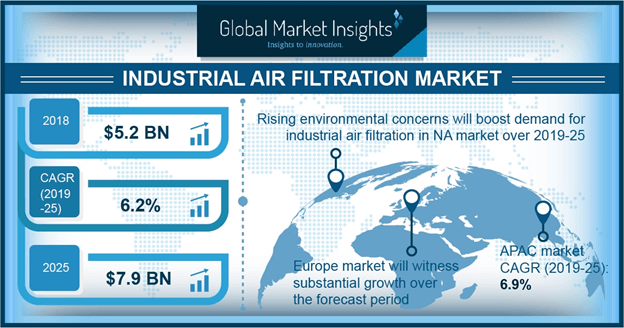Industrial air filtration market to be driven by a stringent regulatory landscape, rising government efforts toward promoting R&D activities to expedite the industry growth over 2018-2024
Publisher : Fractovia | Published Date : 2018-07-30Request Sample
Essentially powered by the increasing deployment of air quality mapping platforms, industrial air filtration market has been witnessing remarkable growth lately. Since the last few years, industrialization trends across the globe have resulted in a severe rise in air pollution levels, the disastrous effects of which have been manifested on biodiversity. In fact, in a few countries, many people have even lost their lives because of health problems created due to polluted air. For the record, in 2012, the World Health Organization (WHO) reported that 7 million of the global populace lost their lives because of rising air pollution levels worldwide.
U.S. Industrial Air Filtration Market Size, By Product, 2017 & 2024, (USD Million)

Given the overt fact that air pollution leads to several respiratory and chronic pulmonary diseases, regional governments have taken initiatives to increase the quality of indoor as well as outdoor air. In order to comply with the regulatory framework mandated with regards to air pollution, most of the companies are now installing different types of air filtering equipment at their facilities – a factor that will favorably impel industrial air filtration industry share.
Speaking along the same lines, most of the European countries and some of the leading regions across the APAC including China, India and South Korea have tightened the regulatory norms related to the industrial sectors – a move that has seemingly helped them improve the country’s economic strategies on a large scale. For instance, a few years before, the European Union (EU) deployed stringent environmental policies to curb air pollution. While drafting the norms, it had considered few core issues related to air pollution which includes hazards to public and occupational health, biodiversity losses, and overuse of natural resources. It had been observed that post the implementation of strict environmental policies, the economic growth of the continent observed a meteoric rise.
The EU had also adopted the Clean Air Policy Package directive in 2013, that estimated the prevention of at least 58,000 deaths per year through the implementation of better policies. The estimates also claimed that close to EUR 40 billion to EUR 140 billion could be saved in external costs while EUR 3 billion could be saved in direct benefits due to reduced healthcare costs, few work sick days, and improved productivity. The deployment of strict regulations by the EU has thus proved to be highly lucrative for the regional industrial air filtration industry.
Taking into account the cost-effective benefits of deploying air filtration systems at the workplace, many companies have been striving to install the same on a large scale, especially across the developed economies, fueling industrial air filtration market size. In the U.S., the regulatory bodies like the Occupational Safety and Health Administration play a pivotal role in encouraging companies to install air quality enhancement equipment for the betterment of occupational health. In fact, the organization has suggested a few recommendations for the employers to prevent health problems generated due to poor indoor air quality.
Post OSHA’s recommendation, many U.S. companies were found to have planned for ventilation, air treatments, and preventive maintenance with regards to air contamination and its impact on employees’ health. Considering the growing need of air treatment facilities across many countries, many giants in industrial air filtration industry have been involved in brainstorming innovative air filtration technologies.
Validating the aforementioned fact, one of the London based start-ups, Smart Separations, recently developed a revolutionary filtration system, which could be implemented across various industries including biomedical and food processing for improving air quality. Taking into account the applicability and cost-effectiveness of newly developed air filtration systems for industrial use, the UK government seems to have pulled up its sleeves to provide financial support for inventing cost-effective air filtration technology, fueling the regional industrial air filtration market outlook.
Aided by staunch government support, industrial air filtration market players plan to launch new advanced products over the coming years. The development of a widespread product portfolio is certain to propel the revenue graph of industrial air filtration industry.
Having recognized the fact that air pollution has emerged as one of the major environmental issues lately, core companies across the automotive, chemical, food processing, oil & gas, mining, and pharmaceutical sectors that inadvertently release hazardous pollutants are now beginning to comply with established government norms. Regional regulatory bodies have deployed strict rules in accordance with which companies have been installing air filtration systems for reducing the release of pollutants into the atmosphere. Powered by the increasing awareness among the industry contributors about the usage of air treatment facilities, industrial air filtration market size has been forecast to surpass a revenue collection of USD 6.5 billion by the end of 2024.